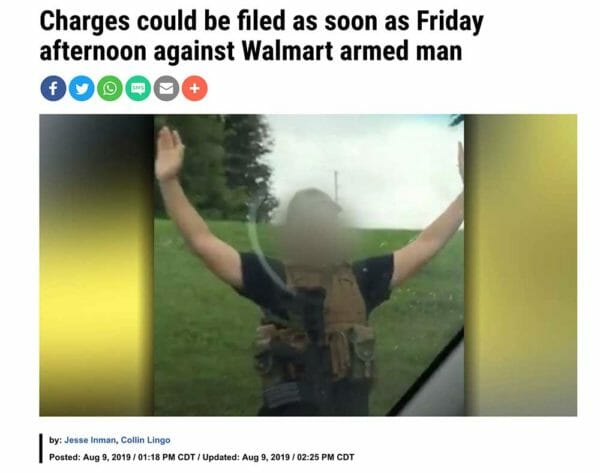
U.S.A. –-(Ammoland.com)- A man with a rifle and a hundred rounds entered a Walmart in Springfield, Missouri less than a week after the mass shooting in El Paso, according to Lt. Mike Lucas of the city’s police department, and moved through the store, taking video and making comments to shoppers, then exited to be held at gunpoint by an off-duty firefighter until law enforcement arrived. The twenty-year-old was originally said to have been wearing body armor, though this later was identified as a “tactical vest.” The suspect is in jail, and a felony charge of a terroristic threat in the second degree has been filed against him. He claims that he was performing a “social experiment,” in part a test of Missouri’s open carry law.
No shots were fired, either by the suspect or the off-duty firefighter, so this incident will not qualify as a mass shooting or to some people as a defensive gun use—the latter being defined by gun control advocates all too often as requiring a justifiable homicide to count. And what exactly the suspect did—was his rifle on a sling or in his hands, was he sweeping the muzzle around at random or pointing it at particular people—isn’t specified in the reports. Nor was the method by which the firefighter was carrying his firearm. What I can say, based on available information, is that a good guy spotted a knucklehead who was creating havoc and brought the incident to a halt.
What happened here has the potential to divide the gun community. The claim made by the suspect puts him into the phenomenon of “Second Amendment auditing,” the practice of walking around in public with an openly carried firearm for the purpose of testing how much law enforcement officers and the general public know about local gun laws. And presuming that the firefighter had his firearm covered prior to seeing the suspect, this sets up a contrast between concealed and open carry.
As a supporter of rights generally, I understand the motivation to make people think about how the law often violates rights or accepts their exercise in unequal ways. Rosa Parks comes immediately to mind, as does the question of how safe a gay couple would be in many parts of America were they to hold hands while in public. At the same time, to take those two examples, if Parks had brought a bass drum with her and insisted on pounding on it during the bus ride, or if the hypothetical gay couple—or any couple, for that matter—were to engage in sex acts on a crowded sidewalk, the situation will have moved away from a test of rights into the imposition of personal choices on others.
In regard to the carrying of firearms, I go back to the distinctions that Jeff Cooper makes between a handgun and a long gun. A handgun is something to wear while doing other things, while a long gun is what you bring when you are going to a fight. This is akin to what separates carrying and brandishing. A weapon in a holster or hanging from a sling is a sign that the person in possession simply has the gun. If, by contrast, the firearm is in the person’s hands, the presumption of intention becomes reasonable.
The suspect in Missouri did cause the reasonable fear that lives were in danger, and given what I know at present, I will say that the firefighter acted appropriately, even if we ultimately learn that what happened was only a test with no plan to kill anyone. We can learn from this incident that good people who carry firearms have a role to play in protecting society. And we can learn that in the context of mass shootings in the news, we who support gun rights have to think about the effects of our behaviors. The appearance of a firearm is going to scare enough people who vote to say that if we do carry openly, it needs to be done in a manner that is as nonthreatening as possible.
By analogy, hold hands with your partner in public, but don’t fornicate on the lawn. Carry your weapon legally, and if you have it visible to others, keep it demonstrably available but not in use. And don’t go around harassing others. A sign in our hands can start a conversation. A firearm in the same narrows the situation down to a tiny number of possibilities.
About Greg Camp
Greg Camp has taught English composition and literature since 1998 and is the author of six books, including a western, The Willing Spirit, and Each One, Teach One, with Ranjit Singh on gun politics in America. His books can be found on Amazon. He tweets @gregcampnc.
